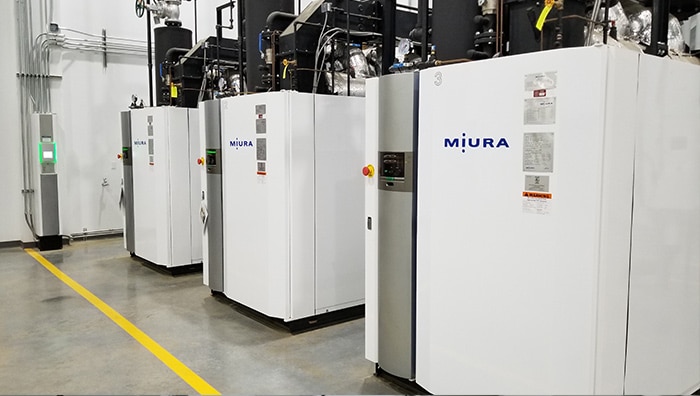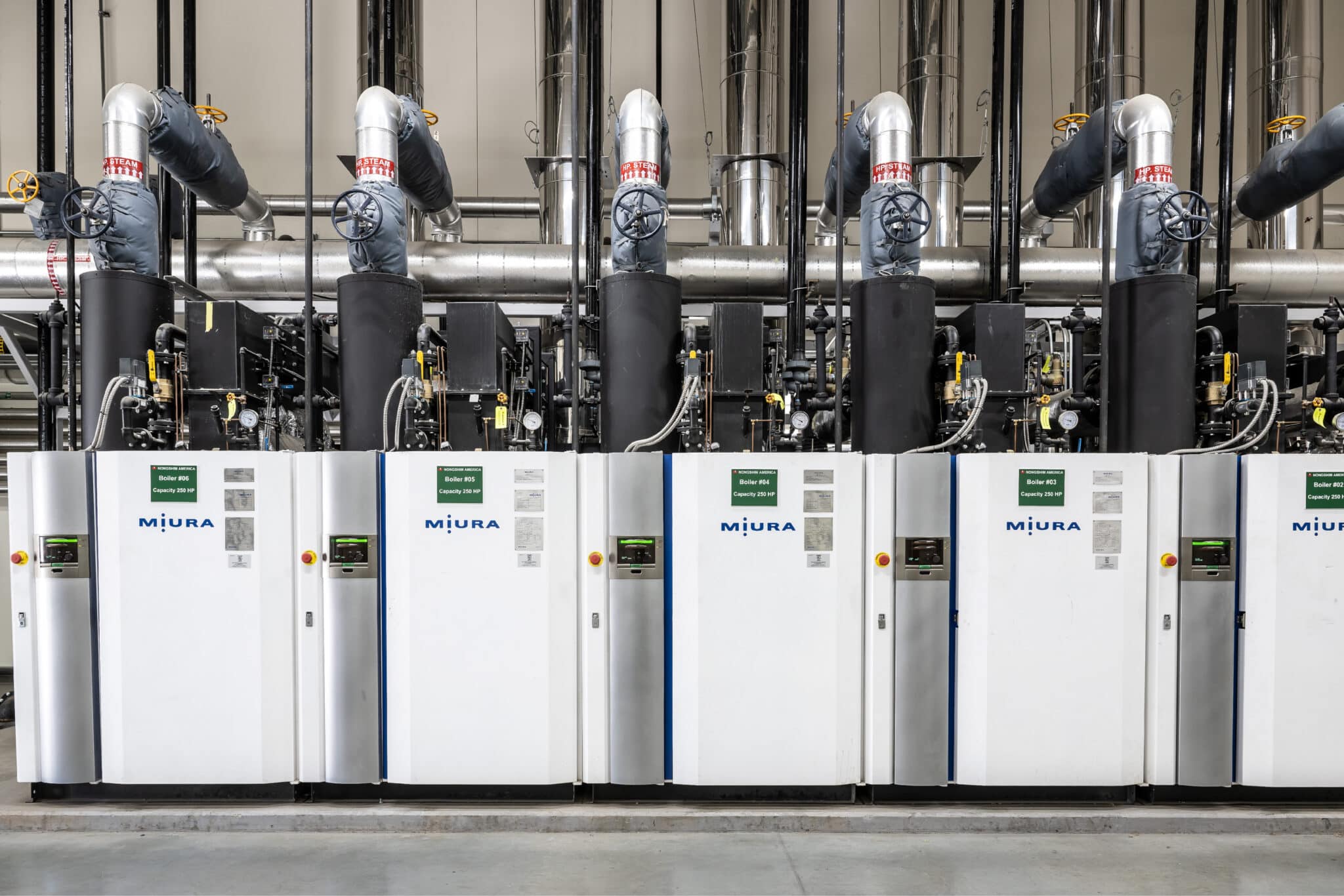How Modular On-Demand Steam Boilers Take Efficiencies to The Next Level
Boiler efficiency is about how effectively a boiler uses fuel to transfer heat and produce steam. Put more simply, how much you get out for what you put in. The less you need to put in, and the more you get out, the more efficient the boiler. And, of course, the more efficient a boiler is, the more cost-effective it is to run.
But what makes one industrial steam boiler more efficient than another? And how does a boiler’s design affect output and running costs? This blog looks at how Miura’s water tube steam boilers offer the highest in-service and fuel-to-steam efficiencies through our modular, on-demand design.
Measuring Industrial Steam Boiler Efficiencies
There are two primary standards for measuring a boiler’s efficiency: fuel-to-steam efficiency and in-service efficiency. These measurements provide valuable information about how well the boiler uses fuel to generate steam and its overall running costs.
While fuel-to-steam efficiency offers a helpful snapshot of a boiler’s efficiency over time, in-service efficiency generally describes a boiler’s efficiency in real-world situations. Let’s consider each standard in turn.
A Recap On Fuel-to-Steam Efficiency
A boiler’s fuel-to-steam ratio calculates its combustion efficiency – in other words, how many pounds of steam it generates compared to how much fuel is used.
Fuel-to-steam efficiency is measured in a unit of heat called a British thermal unit (Btu).
- A Btu measures the heat content of fuels or energy sources – and more specifically, how much heat is required to raise the temperature of one pound of water by 1 degree Fahrenheit.
- This measurement is used to estimate the Btu amount of fuel (coal, natural gas, propane, or #2 fuel oil) a boiler uses to produce the required amount of steam.
- Fuel-to-steam efficiency (also known as Annual Fuel Utilization Efficiency, or AFUE) measures how much heat is lost before steam is produced and leaves the boiler. The more effectively a boiler can minimize heat loss, the more heat is transferred to the boiler water.
For optimal fuel-to-steam efficiencies, you need to minimize all the ways heat escapes the system and maximize the effect of heat used.
What Impacts Fuel-to-Steam Efficiencies?
Before exploring steam boiler design features that offer optimal fuel-to-steam efficiencies, let’s dig into the common causes of heat loss in boilers.
1. Poor Combustion Efficiency
Combustion boilers operate by heating water with a flame to produce steam. Any factors that cause the flame to burn ineffectively – for example, too much air into the boiler versus fuel used – mean that you are getting less heat than possible from your fuel. Therefore, regular boiler inspections, maintenance, and tuning to ensure the optimal ratio of fuel to air to increase the flame’s efficiency are crucial to overall boiler efficiency.
2. Poor Heat Transference Into the Feed Water
Heat transfer is in part a result of a boiler’s design. For example, the surface area of the boiler design can affect heat transfer. In the ordinary course of operations, the areas through which heat transfer takes place (from the flame to water) can also become obstructed, by a build-up of scale, for example, effectively creating an insulation barrier that inhibits the transfer of heat.
3. Poor Steam Quality Causing Wear and Tear
Steam quality is an essential measure of a boiler’s overall performance. The more carry-over moisture in the steam produced by the system, the lower the quality.
Low steam quality also affects efficiency. Any water or steam leak means that more fuel needs to be used to produce the steam required. And that means a lower fuel-to-steam efficiency.
4. Poor Water Treatment Leading to Scale Build-up
As highlighted above, maximizing the heat transfer to the water is critical to fuel efficiency. Scale build-up inside a steam boiler pressure vessel acts as an insulator and prevents the efficient transfer of heat, impacting required energy inputs and steam outputs.
How do Miura Boilers Offer Optimal Fuel-to-Steam Efficiencies?
Considering the factors that affect fuel-to-steam efficiency, we can appreciate the critical value of keeping boilers in good condition, including ensuring no build-up of scale or other issues that could affect combustion.
Regularly tuning the boiler is also essential to ensure an optimal air-fuel mixture. Miura boilers offer advanced diagnostic technology and maintenance programs that ensure your boiler is always running optimally.
But Miura boilers achieve enhanced efficiency for a more fundamental reason. Miura has made several unique design choices that enhance fuel-to-steam efficiency compared to other boilers.
- For one, Miura boilers use a low water content design. Miura boiler pressure vessels only hold around 10% of the water of traditional fire tube boilers. And the less water, the less energy is required to generate steam.
- Miura’s modular configuration also means that each unit is inherently more thermally regulated, thus offering more insulation by design.
- Miura’s unique once-through design offers higher efficiency, which means you need less fuel to produce the steam required.
- Miura boilers also come standard with an economizer, which uses exhaust output to preheat the feedwater. This enables high efficiencies right from the start.
The overall result is a better fuel-to-steam efficiency than other boilers, which means lower operating costs over the boiler’s lifetime.

Traditional fire-tube boilers generally produce up to 83 percent fuel-to-steam efficiencies, at peak operational efficiencies.
The compact design also means that each Miura boiler is much smaller than traditional boilers, which means less surface area through which heat can be lost. Importantly, Miura’s water tube design means less heat loss and highly efficient energy transfer to enable you to produce the steam you need with less fuel.
A Recap On In-Service Efficiency
While fuel-to-steam efficiency is a helpful and relatively straightforward way to measure a boiler’s efficiency, the standard does have limitations.
- Fuel-to-steam efficiency tells you how efficient a boiler is at converting fuel to steam at maximum capacity. However, most boilers are not permanently running at full capacity in real-world applications.
- We can measure a boiler’s actual operational efficiency using a standard known as in-service efficiency. This method accounts for the efficiency at which fuel is converted to steam, as well as additional factors that can cause heat loss. The more comprehensive standard produces a more accurate measurement of overall efficiency.
How do Miura Boilers Offer Optimal In-Service Efficiencies?
We might think of in-service efficiency as the gold standard of boiler efficiency. That’s because it’s a measure of how the boiler will perform in your organization, meeting the fluctuating operational demands of real-world processes.
Miura’s modular boiler system is specifically designed to meet fluctuating demands more efficiently. In practice, many industries require different amounts of steam throughout the day or at different times in the week.
Instead of a single large boiler that takes large amounts of energy to adjust, modular boiler design works by grouping smaller boilers together to function as a single boiler system. It’s a remarkable solution to the problem of variable demand. Each smaller module can begin producing steam from a cold startup in under five minutes, reducing start-up loss and increasing the overall efficiency.
This on-demand system means you can precisely control the amount of steam you require at any point in the day without compromising the boiler’s efficiency. With Miura’s modular steam systems, you can meet fluctuating load demands, conserve fuel, scale production easily, and extend the lifespan of your boiler plant.
Boiler efficiency isn’t simply an abstract technical question.
A more efficient boiler means using less fuel while producing the required steam. Over time, that means substantial savings. To find the boiler that offers the highest efficiency level, you need a system designed to meet the unique demands of your organization.
As your demand for steam changes, you want a boiler system that quickly, effectively, and efficiently meets your needs, providing reliable, cost-effective service. Miura’s unique boiler design and advanced technology do just that.
Miura steam solutions are custom engineered to match your steam demand and load profile as efficiently as possible. Contact a Miura rep to discuss your steam plant optimization needs today!

